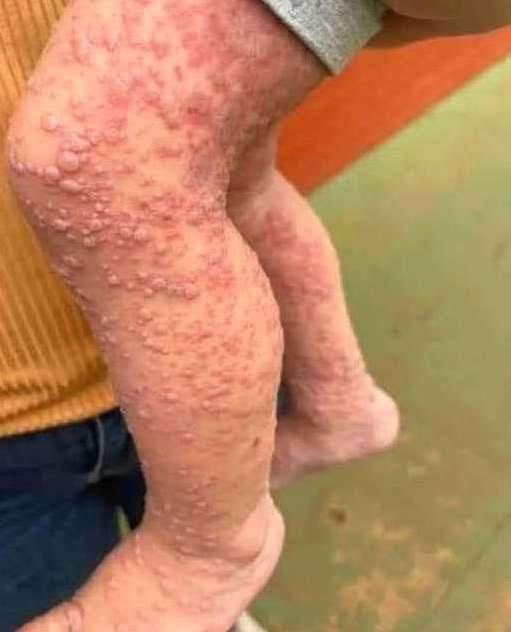It all began with an itchy sensation—a subtle, nagging discomfort on her skin that she initially dismissed as just a minor irritation. Like many of us, she thought it was simply an allergy or a reaction to something she ate, touched, or encountered in her environment. Maybe it was the allergenic pollen in the spring, or maybe a new soap she’d started using. But what started as a minor annoyance quickly grew into something more persistent, more uncomfortable, and increasingly difficult to ignore. At first, it was just a small patch of redness, swollen and itchy, that flared up every now and then. Then, it spread. It became a patchwork of red, swollen, itchy spots that shifted from one part of her body to another.
What seemed like a passing problem, a temporary allergy, soon turned into a real challenge to her well-being. The itch was relentless, worsened by daytime heat and nighttime dryness, robbing her of sleep and peace. She tried everything—over-the-counter creams, cold compresses, even antihistamines. But nothing seemed to give her lasting relief. The patches would flare up again, sometimes worse than before, and her frustration grew. It was as if her skin had become a battleground, and her body was caught in the middle.
Eventually, she decided it was time to see a doctor. She wanted answers, a diagnosis, something that could help her understand what was happening beneath her skin. What she learned surprised her—what she thought was just a simple allergy was actually something quite different: hives. Yes, that common-sounding condition that many mistake for a simple allergic reaction. But hives, or urticaria as they’re medically known, can be complex. They are an immune system response where the body releases histamine and other chemicals in reaction to various triggers, which then cause those characteristic raised, red, swollen patches—what most people call hives.
What makes hives tricky, she learned, is that they can be caused by so many different things: foods, medications, stress, even sudden changes in temperature. Sometimes, they appear suddenly and vanish within a few hours or days. Other times, they linger for months or even years, turning into a chronic condition that requires ongoing management. The unpredictability of it all can be exhausting, both physically and emotionally. One moment, her skin would be clear, and the next, those itchy, swollen bumps would emerge out of nowhere, turning her everyday life into a series of uncomfortable surprises.
The doctor explained the typical signs of hives—reddish or swollen patches that flicker across different parts of the body, often changing location. The intense itch that sounded almost unbearable at times, especially at night, when the quiet and darkness made every sensation seem sharper. The burning or hot sensation accompanying the swelling, making her feel like her skin was on fire. And most frustratingly, the episodes that kept recurring, sometimes with no clear cause or warning, making her afraid to plan outings or even simple errands.
He also emphasized that recognizing these signs early is essential. That if she suspected she had hives, she should seek medical help promptly for proper diagnosis and treatment. While medical therapy—like antihistamines and other medications—can be very effective, there are also natural remedies that can be used alongside medicine to relieve discomfort. It’s not about trying to replace professional treatment but about calming the skin and reducing inflammation naturally, especially when flare-ups are particularly bothersome.
One such natural remedy she found particularly soothing was a simple homemade mask that helped ease her itching and inflammation. It’s inexpensive, easy to prepare, and made with ingredients already in her kitchen. To prepare it, she mixed two tablespoons of ground oats with a cup of cold water until it formed a smooth, creamy paste. Then, she added a tablespoon of pure honey, known for its soothing and healing properties. A few drops of chamomile essential oil, if available, can be added for extra calming effects, though that’s optional. She would apply this mixture directly onto the affected skin—covering the itchy patches—and leave it on for about 15 to 20 minutes. Afterward, she rinsed gently with cool water and patted her skin dry. The oats and honey worked together to reduce inflammation, while the coolness and natural compounds eased the intense itch and burning sensation.
Aside from these remedies, she took some practical steps to prevent future outbreaks. She learned to identify potential triggers—whether it was certain foods like nuts or shellfish, environmental factors such as pollen or pet dander, or even stressful situations that seemed to come out of nowhere. She started wearing loose cotton clothing, which allowed her skin to breathe and avoided irritating synthetic fibers. Keeping her skin well-moisturized with fragrance-free creams became part of her daily routine, especially after showers. She also made a conscious effort to avoid very hot showers, opting instead for lukewarm water that wouldn’t aggravate her skin further.
Through all of this, she realized that managing hives wasn’t just about treating the.


